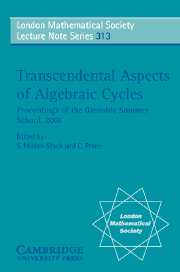Book contents
- Frontmatter
- Contents
- List of participants
- Preface
- Acknowledgements
- Part I Introductory material
- 1 Chow varieties, the Euler–Chow series and the total coordinate ring
- 2 Introduction to Lawson homology
- Part II Lawson (co)homology
- Part III Motives and motivic cohomology
- Part IV Hodge theoretic invariants of cycles
1 - Chow varieties, the Euler–Chow series and the total coordinate ring
from Part I - Introductory material
Published online by Cambridge University Press: 07 May 2010
- Frontmatter
- Contents
- List of participants
- Preface
- Acknowledgements
- Part I Introductory material
- 1 Chow varieties, the Euler–Chow series and the total coordinate ring
- 2 Introduction to Lawson homology
- Part II Lawson (co)homology
- Part III Motives and motivic cohomology
- Part IV Hodge theoretic invariants of cycles
Summary
Introduction
Chow varieties play an important role in the geometry and topology of algebraic varieties. However, their geometry and topology are not well understood. It is important to mention the work of Blaine Lawson, Eric Friedlander, Paulo Lima-Filho and others on the homotopy and topology of the space of cycles with fixed dimension. Chapter 3 by Lima-Filho is relevant in this aspect.
In this article we would like to present other aspects of the geometry and topology of Chow varieties.
In Section 1.1 we introduce Chow varieties and give some important examples. In the last part of this section we mention the case of zero cycles, and we state a theorem where it is shown that they are isomorphic to a certain symmetric product.
In Section 1.2 we study the Euler–Chow series. These are a class of invariants for projective varieties arising from the Euler characteristic of their Chow varieties. It is a series that in a way generalizes the Hilbert series and also appears in many different problems in algebraic geometry. It is also worth mentioning that it belongs, for the correct dimension, as an element in the quantum cohomology of the variety. We do not know what role it plays here, but it shows that a lot more has to be understood before we can get a clear picture of the role of this series in geometry.
- Type
- Chapter
- Information
- Transcendental Aspects of Algebraic CyclesProceedings of the Grenoble Summer School, 2001, pp. 3 - 43Publisher: Cambridge University PressPrint publication year: 2004

